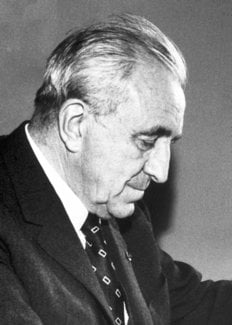Louis Néel
Biographical

Louis Néel was born in Lyons on 22 November 1904. In 1931 he married Hélène Hourticq; they have three children, Marie Françoise, Attachée d’Administration at the Conseil d’Etat, Marguerite, married to Guély, Professeur agrégée d’histoire, and Pierre, who is a television producer. Louis Néel studied at the Ecole Normal Supérieure in Paris from 1924-1928, where he was appointed lecturer in 1928. In 1932 he obtained the degree of Doctor of Science at the University of Strasbourg, where he was appointed Professor at the Faculty of Science (1937-1945). He was Professor in Grenoble since 1945. In 1946 he became Director of the laboratory for electrostatics and metal physics (Centre National de la Recherche Scientifique). From 1954 until 1970 he was Director of the Institut Polytechnique de Grenoble and of the Ecole Française de Papeterie; in 1970 he was appointed President of the Institut National Polytechnique in Grenoble. He served as director of the Centre d’Etudes nucléaires de Grenoble from 1956 to 1970. From 1949 to 1969 he was a member of the Board of Directors of the C.N.R.S.; scientific adviser to the French Navy since 1952; French representative at the Scientific Committee of the North Atlantic Treaty Organization.
Louis Néel began his first research work on magnetism between 1928 and 1939 in Professor Weiss’ laboratory in Strasbourg. Called up for war service in 1939, he worked on the defence of ships of the French fleet against German magnetic mines and invented an effective new method of protection (neutralization). After the Armistice of 1940, he went to Grenoble and established the Laboratoire d’Electrostatique et de Physique du Métal, which in 1946 became one of the external laboratories of the Centre National de la Recherche Scientifique. This laboratory extended rapidly and gave rise to new laboratories; even so, it still has a staff of more than 250 at the present time.
In 1956 Louis Néel created and subsequently developed, as part of the French Atomic Energy Commission, the Centre d’Etudes Nucléaires de Grenoble. He also contributed to the decision to install the Franco-German high-flux reactor in Grenoble (1967).
Although he continued with research, sometimes critical and difficult, on the specific heat of nickel, Louis Néel has mainly concentrated on theoretical problems, which have formed the subject of more than 150 publications. Besides his discovery of the concepts of antiferromagnetism and ferrimagnetism and its consequences, for which he was awarded the Nobel Prize, Louis Néel tackled and solved a number of other problems and extended our knowledge of many aspects of magnetism. The most important of these are as follows: theory of Rayleigh’s Laws; magnetic properties of fine grains; magnetic viscosity; internal dispersion fields; superantiferromagnetism; and hysteresis.
The following distinctions and honours have been awarded to Professor Néel: Chevalier de la Légion d’Honneur (military) in 1940, Officier in 1951, Commandeur in 1958, and Grand Officier in 1966; Croix de Guerre with palms (1940); Commandeur de l’Ordre des Palmes Académiques (I957); Chevalier du Mérite Social (1963); Holweck Prize (1952); old Medal of the Centre National de la Recherche Scientifique (1965). He is a member of the French Academy of Science (Paris, 1953); a foreign member of the Soviet Academy of Science (1959), the Royal Dutch Academy of Science (1959), the Deutsche Akademie der Naturforscher Leopoldina (1964), the Rumanian Academy (1965), the Royal Society (London) (1966), and the American Academy of Arts and Sciences (1966).
Prof. Néel is honorary doctor of the Universities of Graz (1948), Nottingham (1951), Oxford (1958), Louvain (1965), Newcastle (1965), Coimbra (1966), Sherbrooke (1967), and Iassy (1971). He holds an honorary degree from the Polytechnic Institute of Turin (1960). He is an honorary member and former president (1957) of the Société Française de Physique. From 1963 to 1966 he was President of the International Union of Pure and Applied Physics.
This autobiography/biography was written at the time of the award and first published in the book series Les Prix Nobel. It was later edited and republished in Nobel Lectures. To cite this document, always state the source as shown above.
Louis Néel died on November 17, 2000.
Nobel Prizes and laureates
Six prizes were awarded for achievements that have conferred the greatest benefit to humankind. The 14 laureates' work and discoveries range from quantum tunnelling to promoting democratic rights.
See them all presented here.
